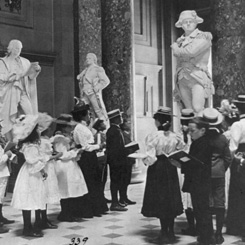 Image courtesy of Library of Congress
This late 19th century image features a group of school children touring the newly created National Statuary Hall.
Image courtesy of Library of Congress
This late 19th century image features a group of school children touring the newly created National Statuary Hall.
On this date, President
Abraham Lincoln signed into law legislation designating the Old Hall of the House as National Statuary Hall. Introduced by Representative
Justin Morrill of Vermont, House Joint Resolution 66 decreed that the former House Chamber would be transformed into an artistic showplace. The legislation authorized the President to invite each state to submit a maximum of two statues for display in the Capitol and appropriated $24,000 for the renovations. The bill prescribed that statues should honor deceased individuals, renowned for their military or civic duty. Led by Representative Morrill, a group of Members grew increasingly concerned that the Old Hall of the House had become a useless storage area and an embarrassment. In the
Congressional Globe, Morrill stated, “The old Hall of the House of Representatives, empty and deserted, remains an unappropriated waste, and as it now appears—draped in cobwebs, and carpeted with dust, tobacco, and apple pomace [referring to apple vendors who set up stands in the old chamber]—a conspicuous nuisance.” On April 19, 1864, the resolution passed the House 87 to 20, but died at the hands of the Senate Committee on Public Buildings and Grounds. Determined not to give up, the House added a slightly reworded version of the joint resolution to an appropriations bill for “sundry civil expenses” for the 1865 fiscal year. Once again, the provision was not agreed to by the Senate. However, during the conference committee, the Senate relented. Using leftover marble from the recent Capitol expansion and a budget of $15,000, renovation began and National Statuary Hall took shape. In 1870, Congress formally received the first statue: Nathanael Greene of Rhode Island.
 Image courtesy of Library of Congress
This late 19th century image features a group of school children touring the newly created National Statuary Hall.
Image courtesy of Library of Congress
This late 19th century image features a group of school children touring the newly created National Statuary Hall.


